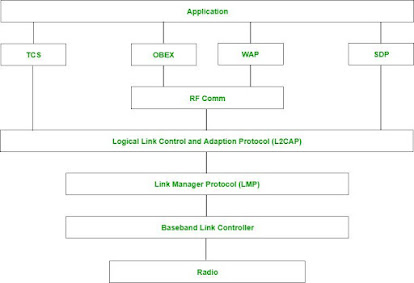Bluetooth
BLUETOOTH
Bluetooth is
a wireless technology that lets devices like phones, tablets, and headphones
connect to each other and share information without needing cables. Bluetooth
simply follows the principle of transmitting and receiving data using radio waves. It can be
paired with the other device which has also Bluetooth but it should be within
the estimated communication range to connect. When two devices start to share
data, they form a network called piconet which can further accommodate more
than five devices.
Key
Features of Bluet
ooth
- The transmission capacity of
Bluetooth is 720 kbps.
- Bluetooth is a wireless
technology.
- Bluetooth is a Low-cost and
short-distance radio communications standard.
- Bluetooth is robust and
flexible.
- The basic architecture unit of
Bluetooth is a piconet
Architecture of Bluetooth
The
architecture of Bluetooth defines two types of networks:
Piconet
Piconet is a
type of Bluetooth network that contains one primary node called the
master node and seven active secondary nodes called slave nodes. Thus, we can
say that there is a total of 8 active nodes which are present at a distance of
10 meters. The communication between the primary and secondary nodes can be
one-to-one or one-to-many. Possible communication is only between the master
and slave; Slave-slave communication is not possible. It also ha
s 255 parked
nodes, these are secondary nodes and cannot take participation in communication
unless it gets converted to the active state.
Scatternet
It is formed
by using various piconets. A slave that is present in one piconet can act as
master or we can say primary in another piconet. This kind of node can receive
a message from a master in one piconet and deliver the message to its slave in
the other piconet where it is acting as a master. This type of node is referred
to as a bridge node. A station cannot be mastered in two piconets.
Bluetooth
Protocol Stack
- Radio (RF) Layer: It specifies the details
of the air interface, including frequency, the use of frequency hopping
and transmit power. It performs modulation/demodulation of the data
into RF
signals. It defines the physical characteristics of Bluetooth
transceivers. It defines two types of physical links: connection-less and
connection-oriented.
- Baseband Link Layer: The baseband is the
digital engine of a Bluetooth system and is equivalent to the MAC sublayer
in LANs. It performs the connection establishment within a piconet,
addressing, packet format, timing and power control.
- Link Manager Protocol Layer: It performs the management
of the already established links which includes authentication and
encryption processes. It is responsible for creating the links,
monitoring their health, and terminating them gracefully upon command or
failure.
- Logical Link Control and
Adaption (L2CAP) Protocol Layer: It is also known as the heart of the Bluetooth
protocol stack. It allows the communication between upper and lower layers
of the Bluetooth protocol stack. It packages the data packets received
from upper layers into the form expected by lower layers. It also performs
segmentation and multiplexing.
- Service Discovery Protocol (SDP)
Layer: It
is short for Service Discovery Protocol. It allows discovering the
services available on another Bluetooth-enabled device.
- RF Comm Layer: It is a cabal replacement
protocol. It is short for Radio Frontend Component. It provides a serial
interface with WAP and
OBEX. It also provides emulation of serial ports over the logical link
control and adaption protocol(L2CAP). The protocol is based on the ETSI
standard TS 07.10.
- OBEX: It is short for Object
Exchange. It is a communication protocol to exchange objects between 2
devices.
- WAP: It is short for Wireless
Access Protocol. It is used for internet access.
- TCS: It is short for Telephony
Control Protocol. It provides telephony service. The basic
function of this layer is call control (setup & release) and group
management for the gateway serving multiple devices.
- Application Layer: It enables the user to
interact with the application.
YADHISIVAN S R (22USC049)







Good
ReplyDeleteGood
ReplyDelete👍
ReplyDelete👍
ReplyDelete